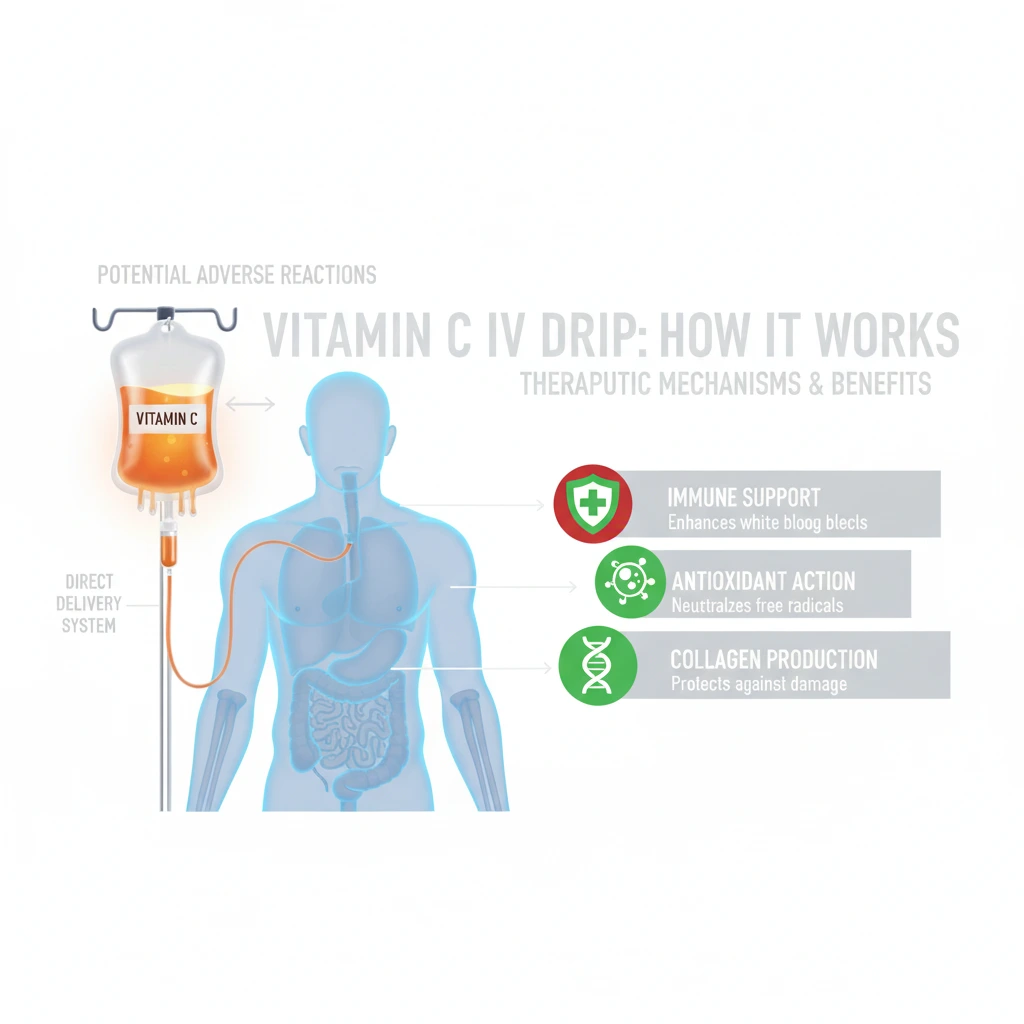More wellness centers now offer vitamin C IV drip treatments. These procedures pump high doses of ascorbic acid directly into your bloodstream through an IV line.
Doctors originally used this therapy in hospitals for patients with severe vitamin C deficiency. Today, healthy people get these treatments hoping to boost their immune system or increase energy levels.
But like any medical procedure, vitamin C IV therapy has risks. Some side effects are minor. Others can be dangerous, particularly for people with certain health conditions.
How This Treatment Works
During a vitamin C IV drip session, you’ll sit in a reclining chair for about an hour or two. A nurse inserts a needle connected to a thin tube into a vein in your arm. The vitamin solution drips slowly through this tube into your bloodstream.

The doses are massive compared to normal vitamin C intake. Most adults need only 75-90 milligrams of vitamin C daily from food. These IV treatments deliver 15,000 to 100,000 milligrams – that’s 150 to 1,000 times more than your body normally processes.
Your digestive system can’t absorb these huge amounts if you took vitamin C pills. That’s why the IV method bypasses your stomach and intestines entirely.
Immediate Problems During Treatment
Pain and Irritation
Your arm will probably hurt where the needle goes in. This isn’t just from the needle stick – it’s because concentrated vitamin C irritates the inside of your veins. The pain might start mild but can get worse as the treatment continues.
Bruising shows up frequently, especially if you bruise easily or take blood thinners. The bruise might appear during treatment or develop over the next day or two. Most bruises fade within a week.
If the IV solution leaks out of your vein into surrounding tissue, your arm will swell up. This is called infiltration. The swollen area often feels cool and tight. When this happens, the nurse needs to stop the IV and restart it somewhere else.
Stomach Problems
Nausea is probably the most common complaint during vitamin iv drip treatments. About one in five patients feels sick to their stomach. The nausea can range from mild queasiness to feeling like you might throw up.
The good news is that slowing down the drip rate usually helps the nausea go away. If you start feeling sick, tell your nurse right away.
Stomach cramps sometimes happen along with nausea. These feel like sharp, twisting pains in your belly. They typically stop once the IV finishes.
Heart and Blood Pressure Issues
Some patients get dizzy or feel faint during treatment. This usually happens because their blood pressure drops. If you’re already prone to low blood pressure or you’re dehydrated, you’re more likely to have this problem.
Your heart might also start racing or beating irregularly. This can be scary, but it usually only lasts a few minutes. Still, you should tell your nurse if you notice any of these symptoms:
- Dizziness or feeling like you might pass out
- Your heart racing or skipping beats
- Breaking out in a cold sweat
- Feeling suddenly weak or shaky
- Trouble catching your breath
What Happens After Treatment
Fatigue
This might surprise you, but many people feel wiped out for several hours after getting a vitamin C IV drip. You’d think all that vitamin C would give you more energy, not less.
The exhaustion happens because your body is working overtime to process such a huge amount of nutrients all at once. Think of it like your system getting overwhelmed. Most people start feeling more energetic within a day or two.
Frequent Urination
Your kidneys have to work extra hard to filter out all that excess vitamin C. This means you’ll be making a lot more urine for the next 12 to 24 hours. Plan to stay close to a bathroom.
Drinking plenty of water helps your kidneys do their job and may reduce other side effects too.
Sleep Disruption
High doses of vitamin C can act like a stimulant. Some people have trouble falling asleep the night after treatment, similar to drinking too much coffee late in the day. This effect usually wears off within 24 to 48 hours.
Serious Complications
| Complication | Details |
|---|---|
| Kidney Damage | – Kidneys process large vitamin C doses, which can be harmful if kidney disease is present. – Vitamin C breaks down into oxalate, which can form kidney stones with calcium. – Rare cases: acute kidney injury from very high doses. |
| Blood Sugar Testing Problems | – In diabetics, vitamin C IV therapy interferes with glucose test strips. – Can cause false high blood sugar readings. – Adjusting insulin based on these false readings can be dangerous. – Effect may last several hours after treatment. |
| Iron Overload | – Vitamin C increases iron absorption. – Dangerous for people with iron storage disorders like hemochromatosis. – Excess iron damages liver, heart, and other organs. – Should be avoided unless closely monitored by specialists. |
High-Risk Patients
Certain people should think twice before getting vitamin C IV drip treatments. If you have G6PD deficiency, high doses of vitamin C can cause your red blood cells to break apart. This condition affects hundreds of millions of people worldwide, though many don’t know they have it.
People with active kidney disease face multiple risks. Their kidneys may not be able to handle the extra vitamin C load.
If you take blood-thinning medications like warfarin, vitamin C might make these drugs work too strongly, increasing your bleeding risk.
Safety Measures
Medical Screening
Reputable clinics check your medical history before treatment. They should ask about kidney problems, medications you take, and previous reactions to vitamins or IV treatments.
Blood tests to check kidney function are particularly important. Some clinics also test for G6PD deficiency.
Choosing a Facility
Only get treatment at licensed medical facilities with trained healthcare providers. The facility should have emergency equipment available in case something goes wrong.
Check the clinic’s licensing with your state health department. Also verify that qualified medical professionals will supervise your treatment.
Starting Slowly
Many doctors recommend beginning with lower doses to see how your body reacts. Starting with 15 to 25 grams is common. You can always increase the dose later if you tolerate the initial treatment well.
Consider these factors when planning treatment:
- Your overall health and any chronic conditions
- Medications that might interact with vitamin C
- Previous history of kidney stones
- How your body has reacted to vitamin supplements before
- Whether you really need such high doses
Monitoring During Treatment
Good facilities check your vital signs throughout the session. They should also watch for signs of adverse reactions and be ready to stop or slow the treatment if problems develop.
Make sure you understand what symptoms to report. Don’t try to tough it out if you’re having problems.
Making an Informed Decision
Vitamin C IV drip therapy isn’t necessary for most people. You can get adequate vitamin C from a healthy diet or regular supplements without the risks that come with IV treatments.
The treatments are expensive and insurance typically doesn’t cover them. Consider whether the potential benefits justify the cost and risks.
Talk to your regular doctor before getting these treatments, especially if you have any health conditions. They know your medical history and can give you personalized advice about whether IV vitamin C makes sense for your situation.
Don’t feel pressured to decide quickly. Take time to research the clinic, understand the risks, and consider alternatives. Your health is worth the extra effort to make an informed choice.

